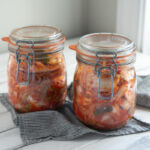
Easy Kimchi (Mak Kimchi with Napa Cabbage)
A quick and easy kimchi recipe made with chopped napa cabbage and spicy seasoning. This mak kimchi is crisp, tangy, and perfect for beginners.
Equipment
- glass food storage jars 1 gallon (3.5 liter) airtight container
Ingredients
- 3 lb (1.3 kg) napa cabbage about 1 medium head
- 2/3 cup (200 g) Korean coarse sea salt
- 1 bunch green onion sliced
- 2-3 fresh red chili (optional) sliced
For kimchi paste
- 1/2 large onion diced
- 7-8 cloves garlic
- 1 inch (2.5 cm) ginger peeled and diced
- 1/2 large sweet apple seeded and diced
- 2/3 cup (60 g) Korean chili flakes (gochugaru)
- 1 tbsp (12 g) sugar
- 4 tbsp (60 ml) Korean anchovy sauce
- 1 tbsp (15 ml) Korean salted shrimp
- 3 tbsp (45 g) cooked white rice
- 1/2 cup (120 ml) sea kelp stock or water (See note)
Instructions
To salt brine the cabbage
- Cut a 3-inch slit through the white stem part of cabbage. Open up the cabbage from the white stem part using your hand. It should open up easily. Cut additional slits on each cabbage half on the stem and open up again. By doing so, you are quartering the cabbage the Korean traditional way. Rinse the cabbage quarters once to wet them.
- Dice cabbage quarters into large chunks. For the large outer leaves, slice them in half lengthwise first, then dice into chunks.
- In a large bowl, put in a small layer of cabbage chunks and sprinkle about 2-3 tablespoons of coarse sea salt over the cabbage. Repeat the process several times, creating layers of cabbage chunks and salt.
- Let the cabbage soak for 1-2 hours, turning them upside down a couple of times during the soaking. When you bend the white stem part of cabbage, if it bends with a gentle pressure, the brine step is completed. Rinse the cabbage 3 times in water. Drain the cabbage in a colander, pressing down gently to remove excess water.
To make kimchi paste
- Combine onion, garlic, ginger, salted shrimps, fish sauce, cooked rice (or other choice of starch), and fruit in a blender. Pour in sea kelp stock (or water) to allow the blade to mix the ingredients. (If using fruit nectar, you don't need to add stock.) Process everything until smooth.
- Pour the puree in a large mixing bowl. Add Korean chili flakes, and mix well. Taste and adjust the seasoning of paste for your liking. Let the paste rest for 5 minutes, so the chili flakes will get re-hydrated.
To assemble kimchi
- Put the drained cabbage in a large mixing bowl. Add leek (or green onion), fresh chili (if using), and kimchi paste to the cabbage.
- Mix well to coat the cabbage with the seasoning paste. (Wear kitchen rubber gloves to protect your hands from getting stained or smelly.) Taste your kimchi! If your kimchi tastes saltier than you would hope for, don't worry! Freshly made kimchi usually taste much saltier, but the saltiness will subdue as it ferments.
To ferment and store kimchi
- Pack kimchi tightly into a clean glass jar, leaving 1 inch of headspace. Seal with a lid and let sit at room temperature (60–75°F / 15–24°C) for 1–2 days until light bubbling appears. Transfer to refrigerator and let ferment 4–5 days before serving. Best within 1–2 months.
Notes
How to make sea kelp stock: Simmer 2 cups water with a piece of dried sea kelp (dashima) in a pot over low heat for 5 minutes. Discard the sea kelp and let the stock cool.
Keep the odor out: Fermented kimchi produces odor. Keep 1-2 box of odor absorbing baking soda in your fridge to keep the other food from the smell.
Nutrition
Calories: 15kcal | Carbohydrates: 3g | Protein: 0.8g | Fat: 0.1g | Sodium: 222mg | Fiber: 1.2g | Sugar: 1.5g | Vitamin A: 287IU | Vitamin C: 13.8mg | Calcium: 25mg | Iron: 0.4mg